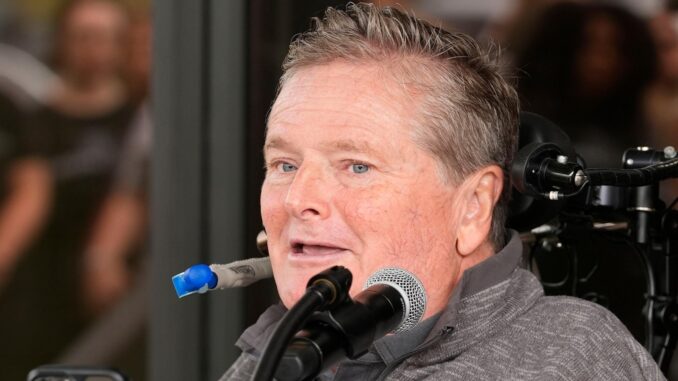
Paralyzed in a racing accident nearly 25 years ago, Sam Schmidt has spent much of the last quarter century trying to prove to others that there is a way to have a meaningful life with a traumatic spinal cord injury.
That was the furthest thing from his mind when he crashed at Walt Disney World Speedway in the opening days of 2000. He suffered a C3 and C4 spinal cord injury, wasn’t breathing for almost four minutes, and had to be helicoptered to Orlando.
His wife was at home in Las Vegas with their children, and when she arrived in Florida, the prognosis was grim.
“We’re lucky he survived the night and if he survives the week, just find him a nursing home,” Schmidt told The Associated Press, detailing what the doctors relayed to his wife. “He’ll be on a ventilator the rest of his life.”
Schmidt’s injury at the time was compared to “the same as Christopher Reeve,” in that, like the ”Superman” actor, Schmidt was paralyzed from the neck down and needed a ventilator to breathe. Reeve reached out — he’d been working with doctors, pushing them, to find ways to help trauma patients create meaningful lives post accident — and Schmidt believes it was Reeve’s work that changed the trajectory of his life.
“There was no internet. My family was at the end of the hospital hallway on the payphones just calling, calling, calling, and all they were told was ‘We’ll teach him how to live with it, but that’s it,’” Schmidt told the AP.
It was Reeve’s doctor who demanded immediate action, and a surgeon for an NFL team operated immediately.
“It was either that or wear a halo for a year, and I wasn’t wearing a halo for a year,” Schmidt said. “So they did the surgery and got me off the ventilator in three weeks. It was Christopher Reeve, the first guy of notoriety, to say ‘No. Why? Tell me why we can’t fix this.’ And thank God he did because I never would have made it to a year.”
In the almost 25 years since, Schmidt has tried to give back and help others with similar injuries find some normalcy in their new lives. He first opened the Driven NeuroRecovery Center six years ago in Las Vegas, where Schmidt lives, and then set his sights on something bigger.
It came Tuesday with the ribbon-cutting on a not-for-profit Conquer Paralysis Now center in partnership with NeuroHope, an Indianapolis-based nonprofit, outpatient physical rehabilitation center.
The center, located in the former Five Seasons Sports Club, is a 114,000-square-foot building devoted to helping people with spinal cord injuries and other neurological disorders. Schmidt, as a former professional athlete, knows his situation was far different than others who have suffered similar injuries.
He can cite divorce statistics, understands the hopelessness that comes when the insurance runs out, and the lack of resources and rehabilitation access are so hard to find. He found himself living it all over again in 2018 when Robert Wickens, who was driving for Schmidt’s IndyCar team at the time, crashed at Pocono Raceway and was paralyzed from the waist down.
Even though Schmidt could relate and team sponsorship from technology provider Arrow Electronics provided resources not generally affordable or accessible to the general public, Schmidt recognized a need for more. Once released from the hospital, Wickens had to relocate to Denver to do his rehabilitation with Arrow at its headquarters.
“The statistics are pretty ugly. We just get stories left and right every week of people trying to deal with these challenges and it’s not very pretty,” Schmidt said. “How do they adapt their home? They get a bed dropped off in the living room and the insurance money is spent and nobody has any idea what to do next.”
That’s the purpose of Driven in Indianapolis, which has a Yard of Bricks like Indianapolis Motor Speedway lining the opening. Roger Penske was the first person to purchase a founding member brick.
The Tuesday ceremony was attended by several current IndyCar drivers and IMS track president Doug Boles, and when visitors entered the facility, it was already full of patients being tended to by physical therapists.
Driven has been designed to help more than just spinal cord injuries. It can accomodate 25 different neuro-disabilities from strokes, brain injuries and Parkinson’s disease. NeuroHope plans to bring its operation into the facility with 200 clients.
Schmidt has cut a deal with a nearby hotel for discounted rates for patients seeking treatment at Driven, which has aquatic pools, rehab equipment and facilities for wheelchair basketball, rugby and tennis.
The upper floor will eventually be the center’s client base and be used for wheelchair repair, mental health services, K9 companions, financial aid and more. Schmidt said there is also a demo apartment and kitchen that will be used to help patients learn how to adapt to their new lifestyle.
“A lot of these people don’t have the money to convert their homes or their apartments,” Schmidt said. “They’re going to need to adapt to a conventional space.”
Schmidt took a long pause when asked if his work on helping others with similar injuries will be his legacy. Seven years before Wickens’ crash, Dan Wheldon was killed at Las Vegas Motor Speedway driving one of Schmidt’s car.
Both incidents make him emotional to this day. But both only pushed his desire to do more for the community — and some of it starts with difficult conversations.
“It’s a lot of work, so I tell them, ‘You have a choice to make. Do you want to sit at home and do nothing?’” Schmidt said. “‘You will probably have a pretty short life because your body will deteriorate. Or, do you want to figure out what your next passion is in life? And, if so, we’ll help you.’”
___
AP auto racing: https://apnews.com/hub/auto-racing


Be the first to comment